Stakeholder Engagement and Business Strategy at Kaffeine Coffee House
VerifiedAdded on 2023/01/10
|12
|743
|95
Presentation
AI Summary
This presentation analyzes Kaffeine, a coffee house in London, from a stakeholder perspective. It begins with an introduction and literature review on stakeholder theory, defining stakeholders and their impact on business operations. The analysis section examines the impact of internal stakeholders (employees and managers) and external stakeholders (suppliers, customers, investors, etc.) on Kaffeine. It then explores Kaffeine's responses to stakeholder issues, including Corporate Social Responsibility (CSR) and business ethics. The paper uses a stakeholder matrix to categorize stakeholders based on their power and interest. The conclusion emphasizes the importance of stakeholder analysis for businesses like Kaffeine to improve engagement, attract investment, and enhance brand image. The presentation includes references to academic journals and online sources.

Individual presentation paper
Paraphrase This Document
Need a fresh take? Get an instant paraphrase of this document with our AI Paraphraser
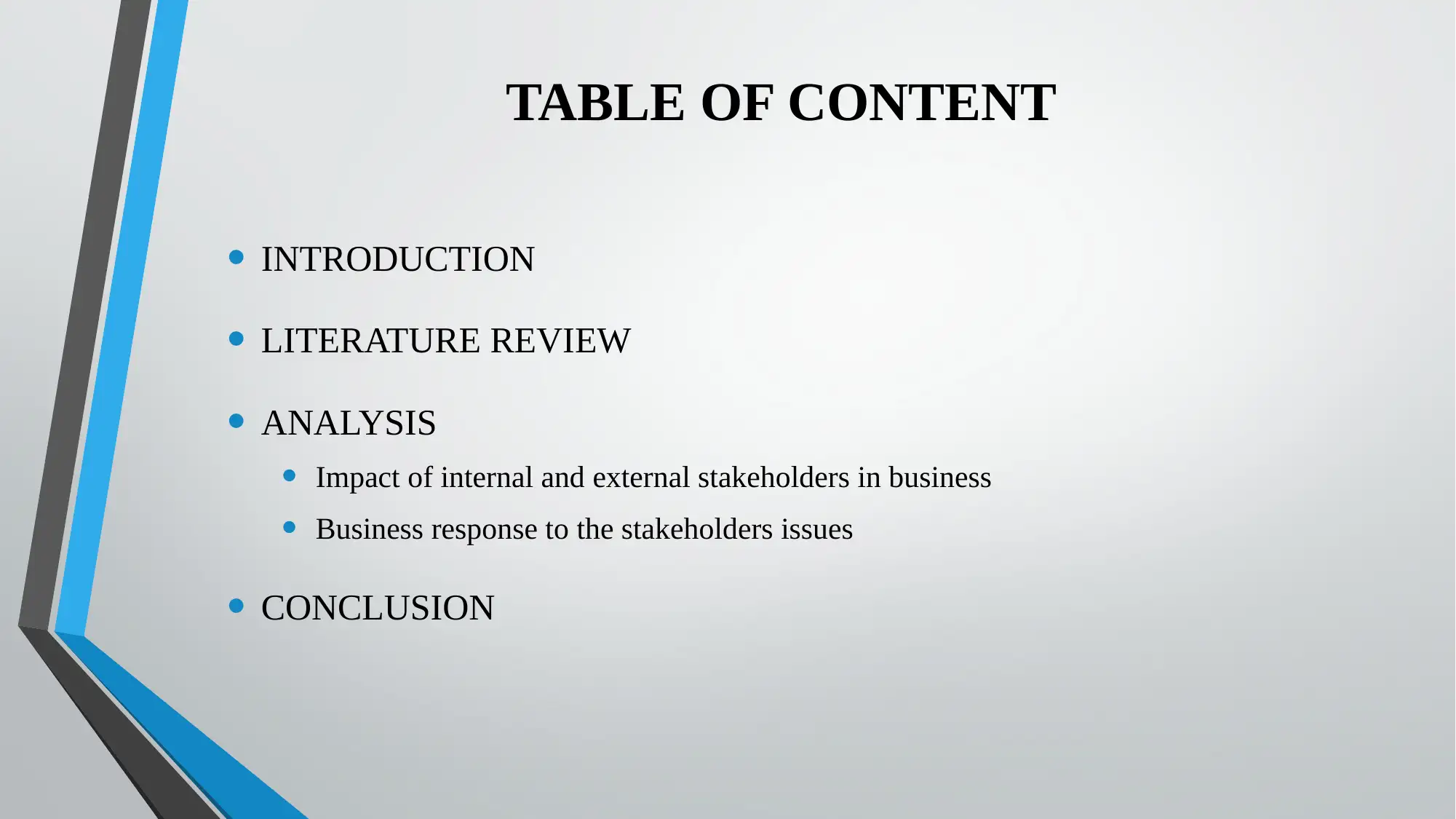
TABLE OF CONTENT
• INTRODUCTION
• LITERATURE REVIEW
• ANALYSIS
• Impact of internal and external stakeholders in business
• Business response to the stakeholders issues
• CONCLUSION
• INTRODUCTION
• LITERATURE REVIEW
• ANALYSIS
• Impact of internal and external stakeholders in business
• Business response to the stakeholders issues
• CONCLUSION

Introduction
Kaffeine is a coffee house operating in London, United Kingdom. This coffee
house is an inspired business venture from the amazing coffee culture in
Australia and New Zealand. This organisation is an independently owned café
and espresso bar. This organisation has two stores in the region of London,
United Kingdom.
Kaffeine is a coffee house operating in London, United Kingdom. This coffee
house is an inspired business venture from the amazing coffee culture in
Australia and New Zealand. This organisation is an independently owned café
and espresso bar. This organisation has two stores in the region of London,
United Kingdom.
⊘ This is a preview!⊘
Do you want full access?
Subscribe today to unlock all pages.

Trusted by 1+ million students worldwide
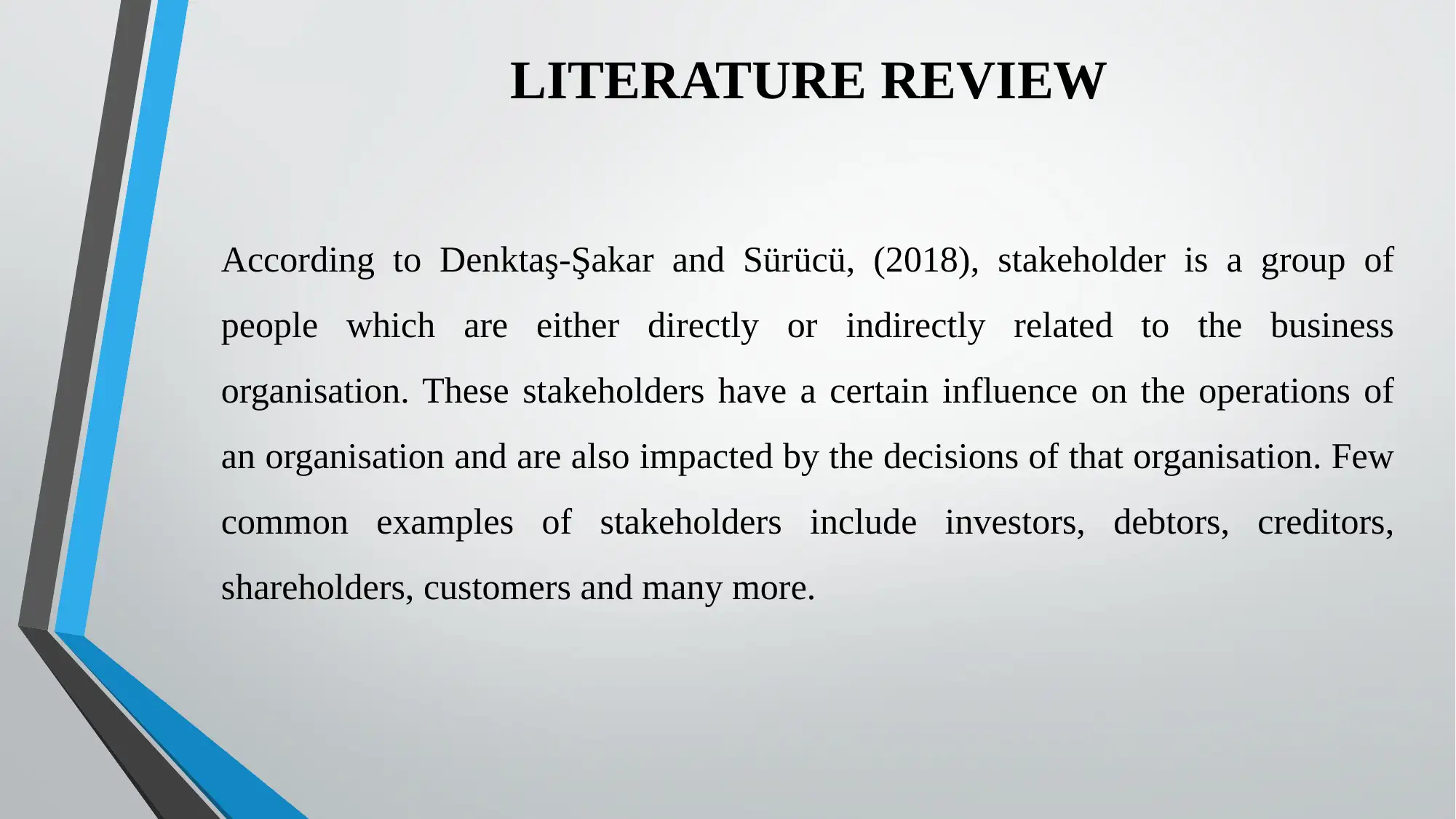
LITERATURE REVIEW
According to Denktaş-Şakar and Sürücü, (2018), stakeholder is a group of
people which are either directly or indirectly related to the business
organisation. These stakeholders have a certain influence on the operations of
an organisation and are also impacted by the decisions of that organisation. Few
common examples of stakeholders include investors, debtors, creditors,
shareholders, customers and many more.
According to Denktaş-Şakar and Sürücü, (2018), stakeholder is a group of
people which are either directly or indirectly related to the business
organisation. These stakeholders have a certain influence on the operations of
an organisation and are also impacted by the decisions of that organisation. Few
common examples of stakeholders include investors, debtors, creditors,
shareholders, customers and many more.
Paraphrase This Document
Need a fresh take? Get an instant paraphrase of this document with our AI Paraphraser
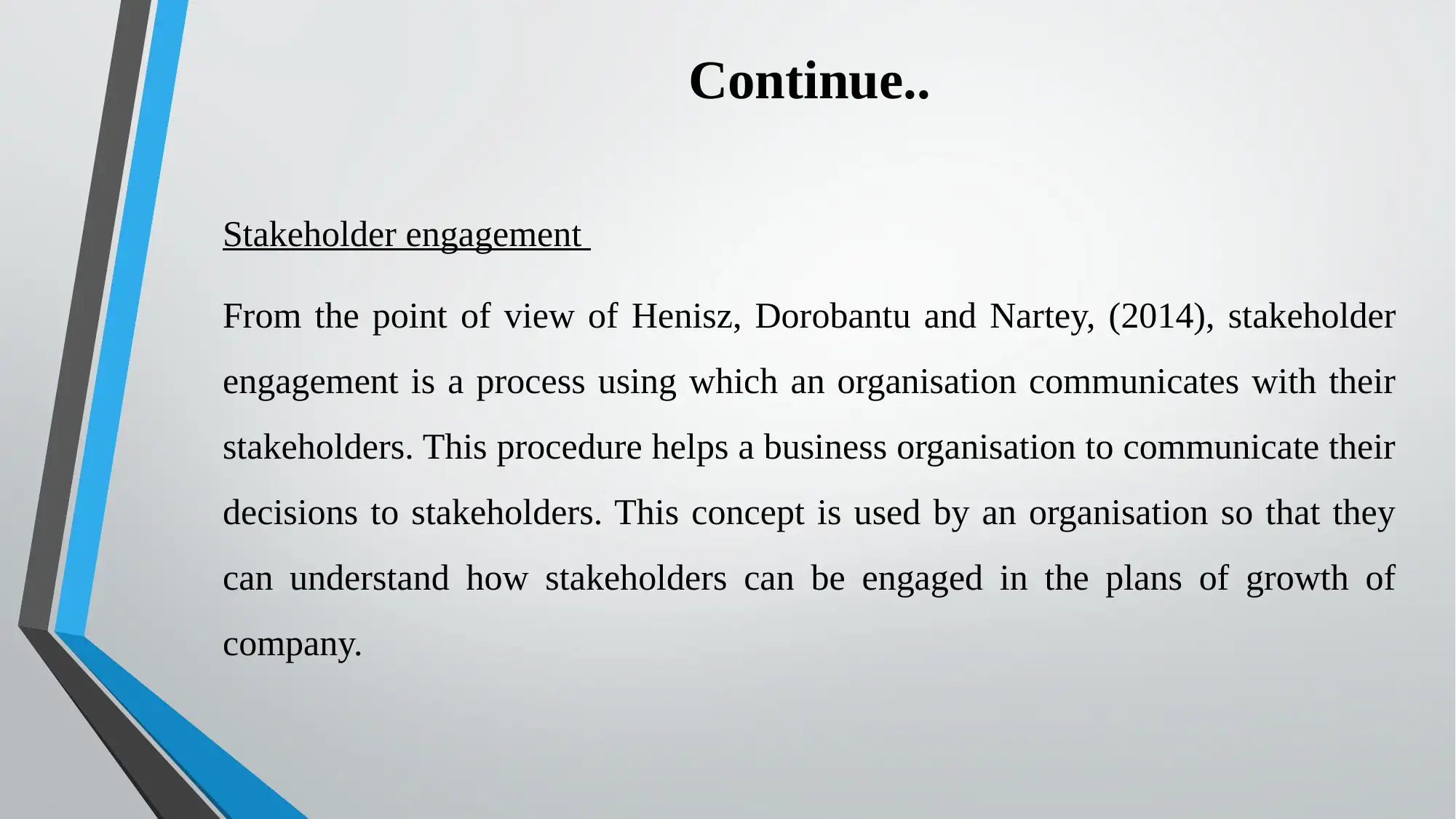
Continue..
Stakeholder engagement
From the point of view of Henisz, Dorobantu and Nartey, (2014), stakeholder
engagement is a process using which an organisation communicates with their
stakeholders. This procedure helps a business organisation to communicate their
decisions to stakeholders. This concept is used by an organisation so that they
can understand how stakeholders can be engaged in the plans of growth of
company.
Stakeholder engagement
From the point of view of Henisz, Dorobantu and Nartey, (2014), stakeholder
engagement is a process using which an organisation communicates with their
stakeholders. This procedure helps a business organisation to communicate their
decisions to stakeholders. This concept is used by an organisation so that they
can understand how stakeholders can be engaged in the plans of growth of
company.
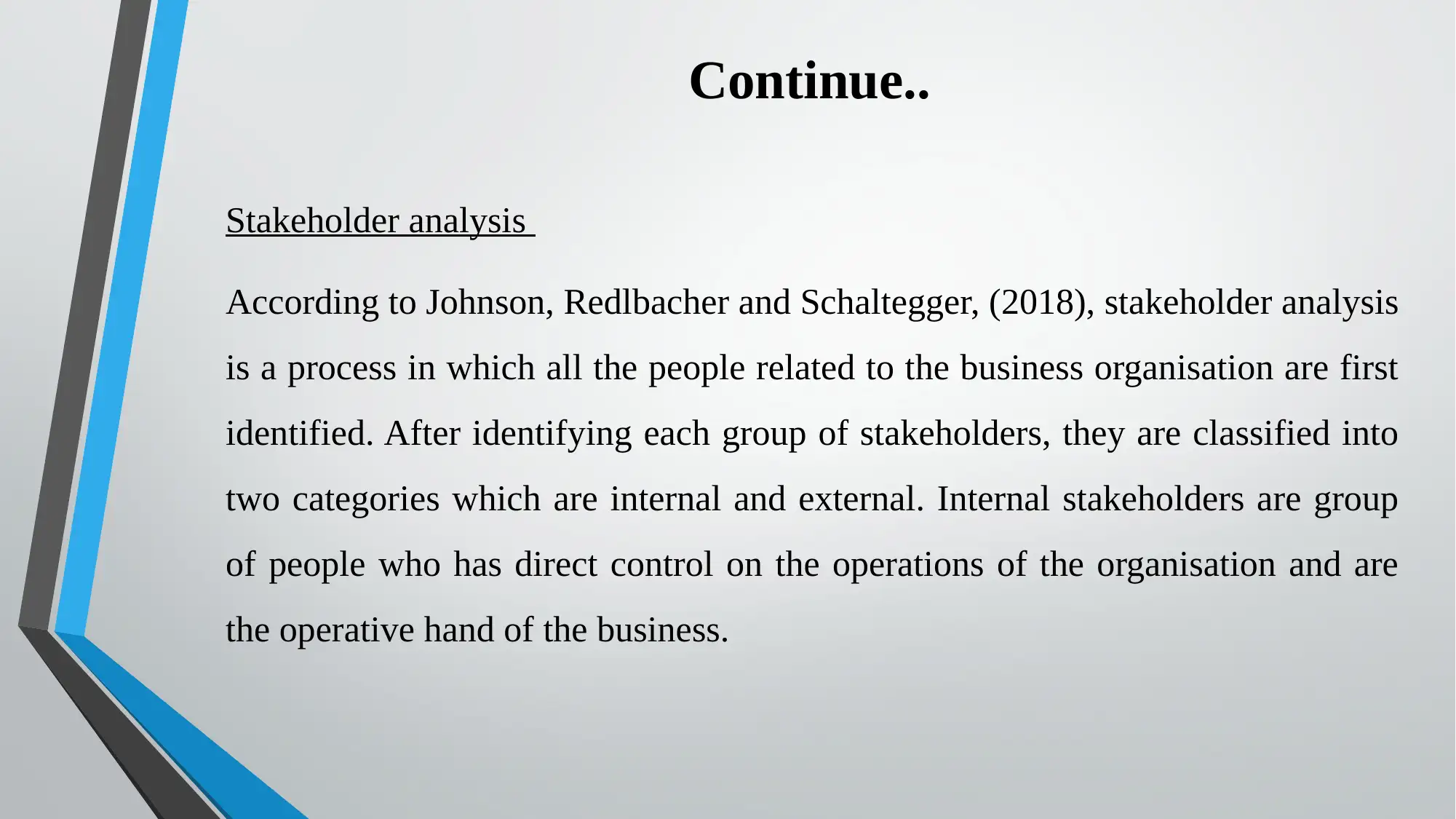
Continue..
Stakeholder analysis
According to Johnson, Redlbacher and Schaltegger, (2018), stakeholder analysis
is a process in which all the people related to the business organisation are first
identified. After identifying each group of stakeholders, they are classified into
two categories which are internal and external. Internal stakeholders are group
of people who has direct control on the operations of the organisation and are
the operative hand of the business.
Stakeholder analysis
According to Johnson, Redlbacher and Schaltegger, (2018), stakeholder analysis
is a process in which all the people related to the business organisation are first
identified. After identifying each group of stakeholders, they are classified into
two categories which are internal and external. Internal stakeholders are group
of people who has direct control on the operations of the organisation and are
the operative hand of the business.
⊘ This is a preview!⊘
Do you want full access?
Subscribe today to unlock all pages.

Trusted by 1+ million students worldwide
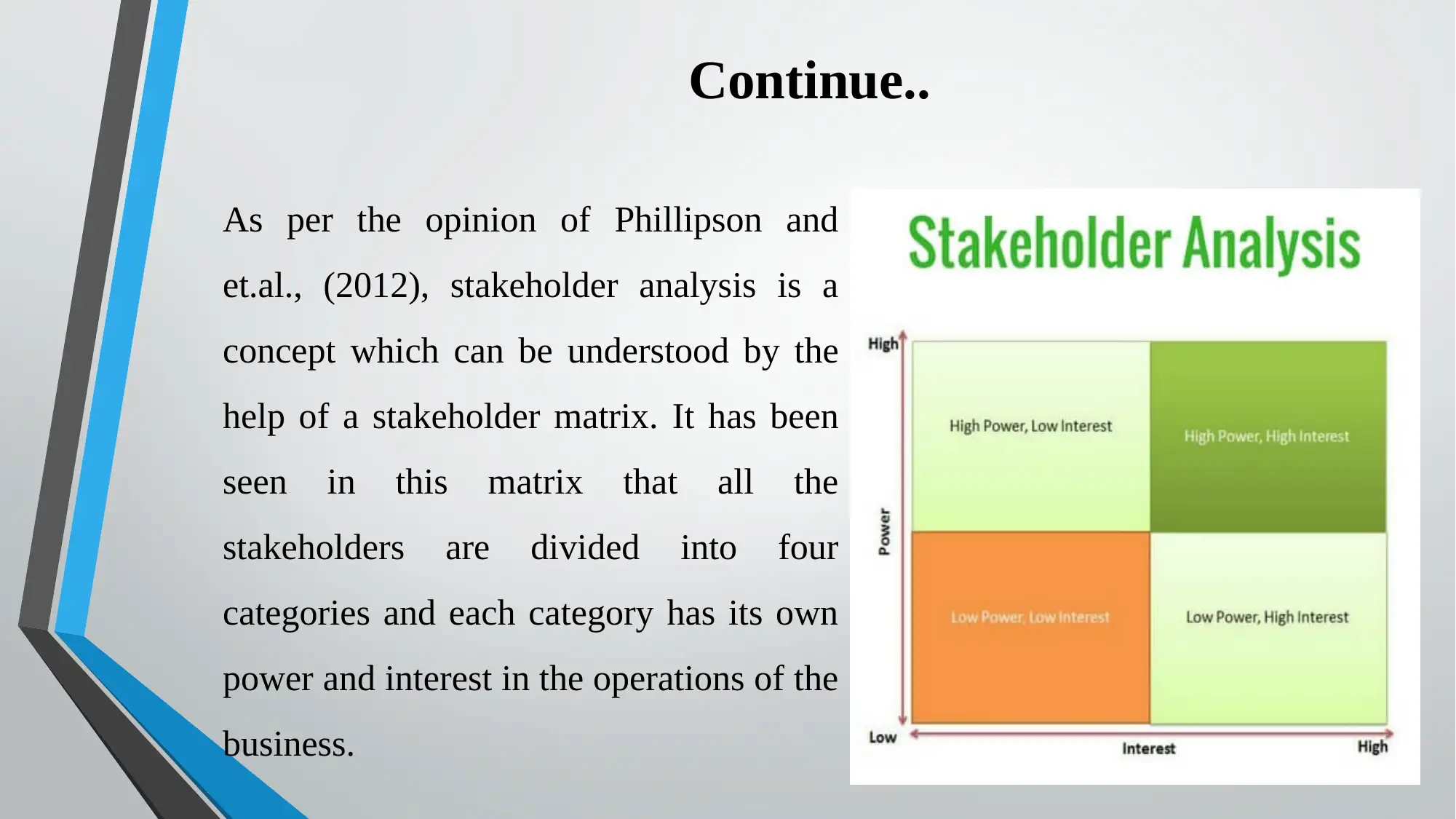
Continue..
As per the opinion of Phillipson and
et.al., (2012), stakeholder analysis is a
concept which can be understood by the
help of a stakeholder matrix. It has been
seen in this matrix that all the
stakeholders are divided into four
categories and each category has its own
power and interest in the operations of the
business.
As per the opinion of Phillipson and
et.al., (2012), stakeholder analysis is a
concept which can be understood by the
help of a stakeholder matrix. It has been
seen in this matrix that all the
stakeholders are divided into four
categories and each category has its own
power and interest in the operations of the
business.
Paraphrase This Document
Need a fresh take? Get an instant paraphrase of this document with our AI Paraphraser
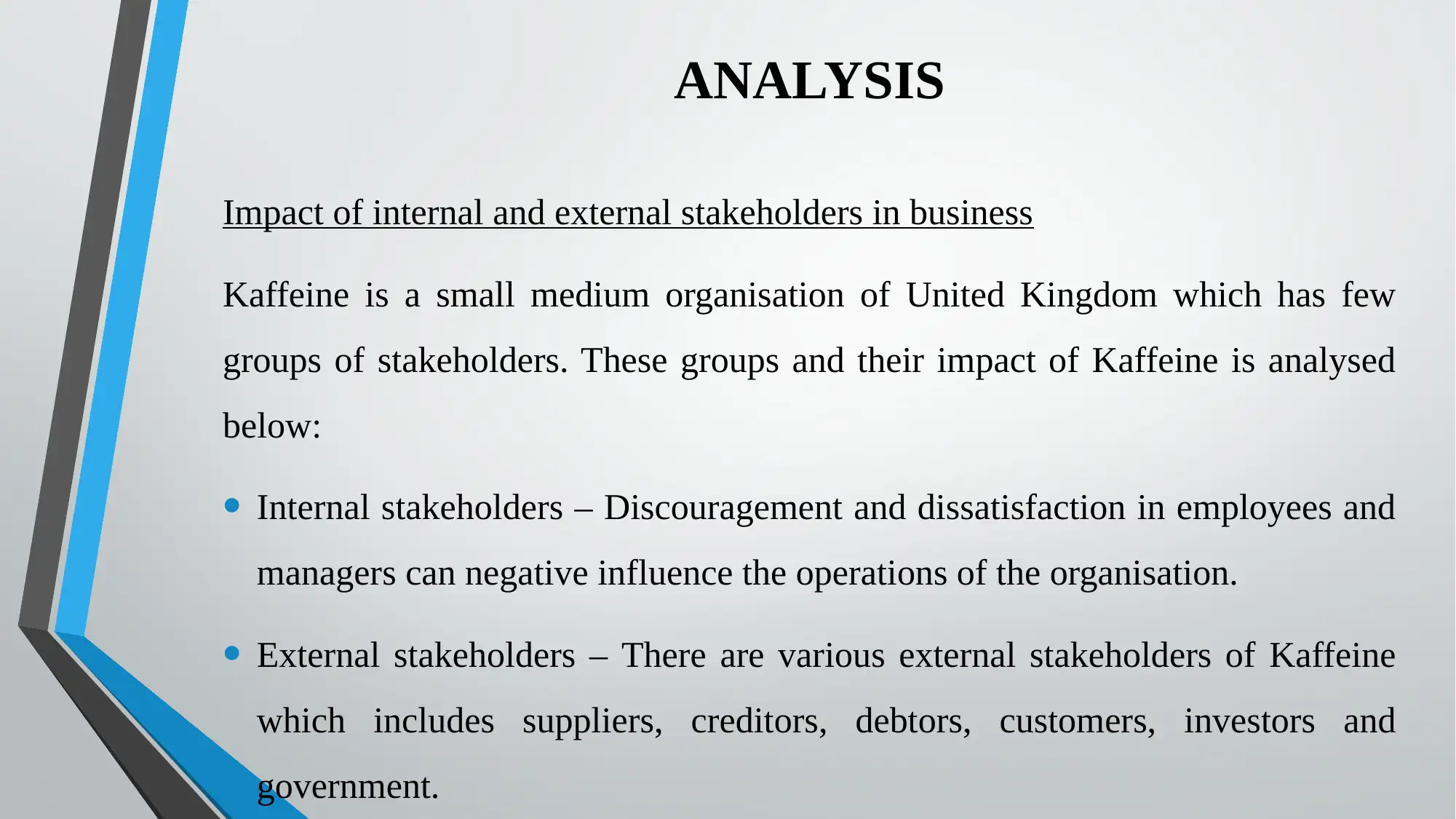
ANALYSIS
Impact of internal and external stakeholders in business
Kaffeine is a small medium organisation of United Kingdom which has few
groups of stakeholders. These groups and their impact of Kaffeine is analysed
below:
• Internal stakeholders – Discouragement and dissatisfaction in employees and
managers can negative influence the operations of the organisation.
• External stakeholders – There are various external stakeholders of Kaffeine
which includes suppliers, creditors, debtors, customers, investors and
government.
Impact of internal and external stakeholders in business
Kaffeine is a small medium organisation of United Kingdom which has few
groups of stakeholders. These groups and their impact of Kaffeine is analysed
below:
• Internal stakeholders – Discouragement and dissatisfaction in employees and
managers can negative influence the operations of the organisation.
• External stakeholders – There are various external stakeholders of Kaffeine
which includes suppliers, creditors, debtors, customers, investors and
government.
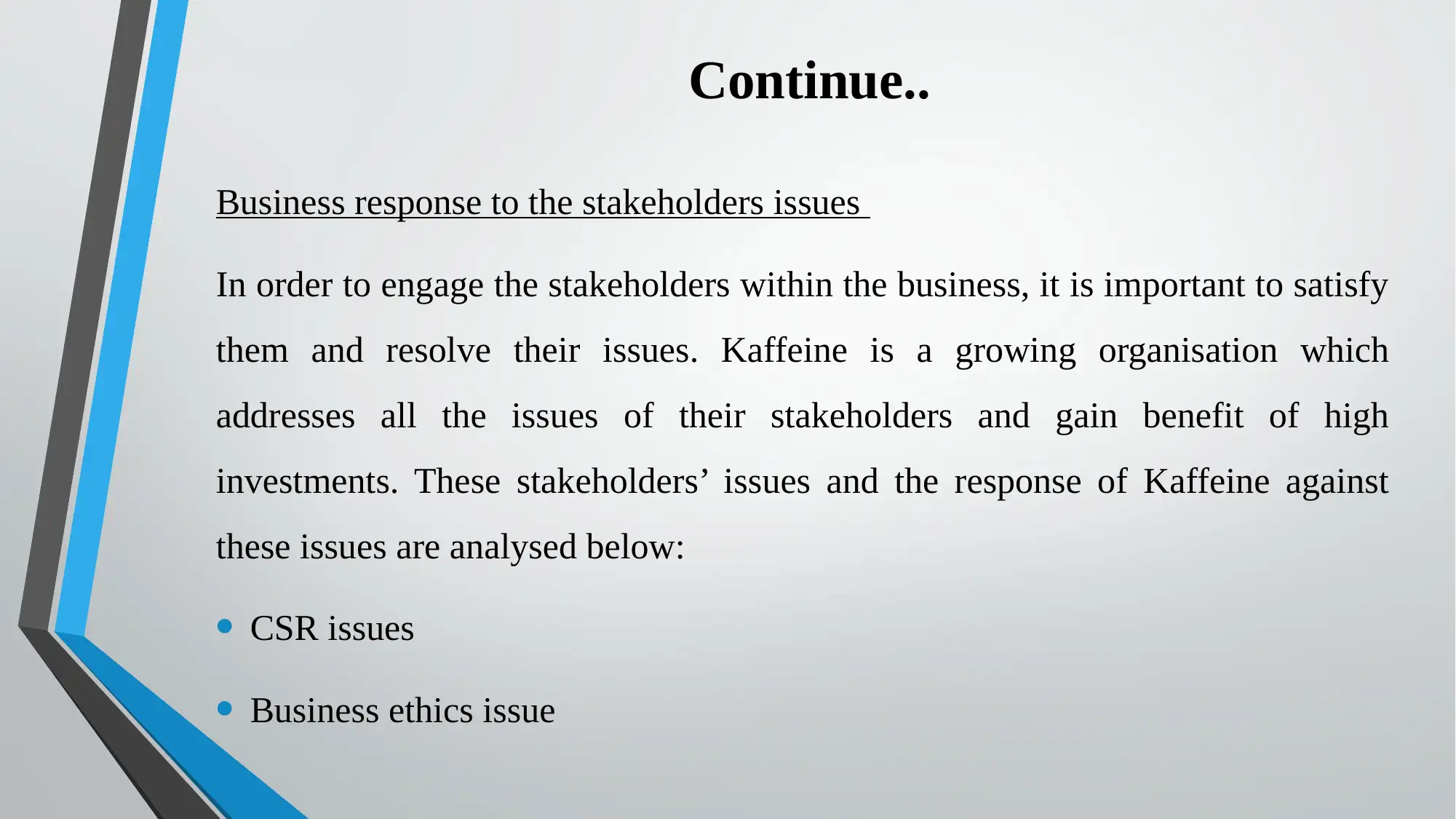
Continue..
Business response to the stakeholders issues
In order to engage the stakeholders within the business, it is important to satisfy
them and resolve their issues. Kaffeine is a growing organisation which
addresses all the issues of their stakeholders and gain benefit of high
investments. These stakeholders’ issues and the response of Kaffeine against
these issues are analysed below:
• CSR issues
• Business ethics issue
Business response to the stakeholders issues
In order to engage the stakeholders within the business, it is important to satisfy
them and resolve their issues. Kaffeine is a growing organisation which
addresses all the issues of their stakeholders and gain benefit of high
investments. These stakeholders’ issues and the response of Kaffeine against
these issues are analysed below:
• CSR issues
• Business ethics issue
⊘ This is a preview!⊘
Do you want full access?
Subscribe today to unlock all pages.

Trusted by 1+ million students worldwide
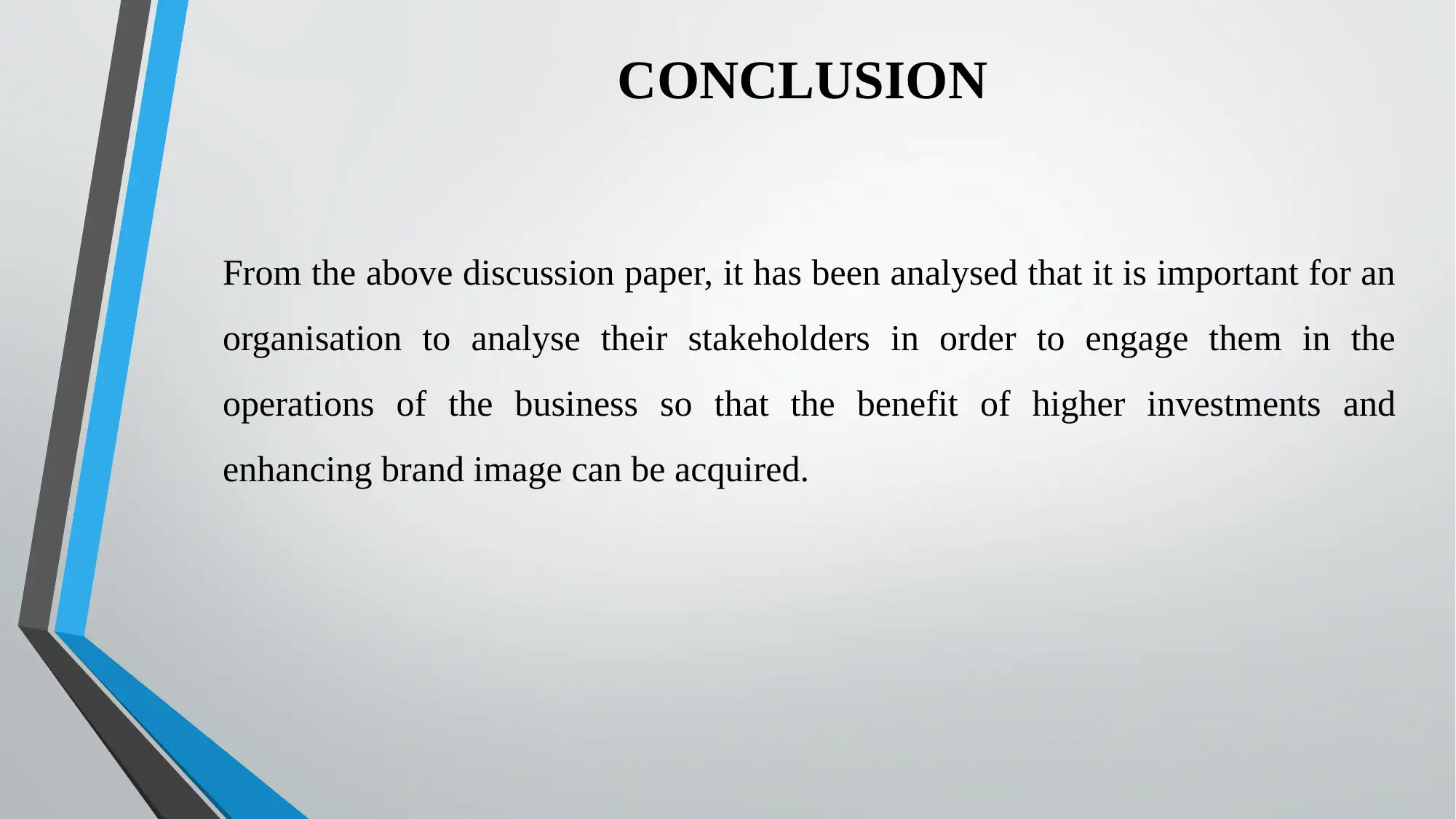
CONCLUSION
From the above discussion paper, it has been analysed that it is important for an
organisation to analyse their stakeholders in order to engage them in the
operations of the business so that the benefit of higher investments and
enhancing brand image can be acquired.
From the above discussion paper, it has been analysed that it is important for an
organisation to analyse their stakeholders in order to engage them in the
operations of the business so that the benefit of higher investments and
enhancing brand image can be acquired.
Paraphrase This Document
Need a fresh take? Get an instant paraphrase of this document with our AI Paraphraser
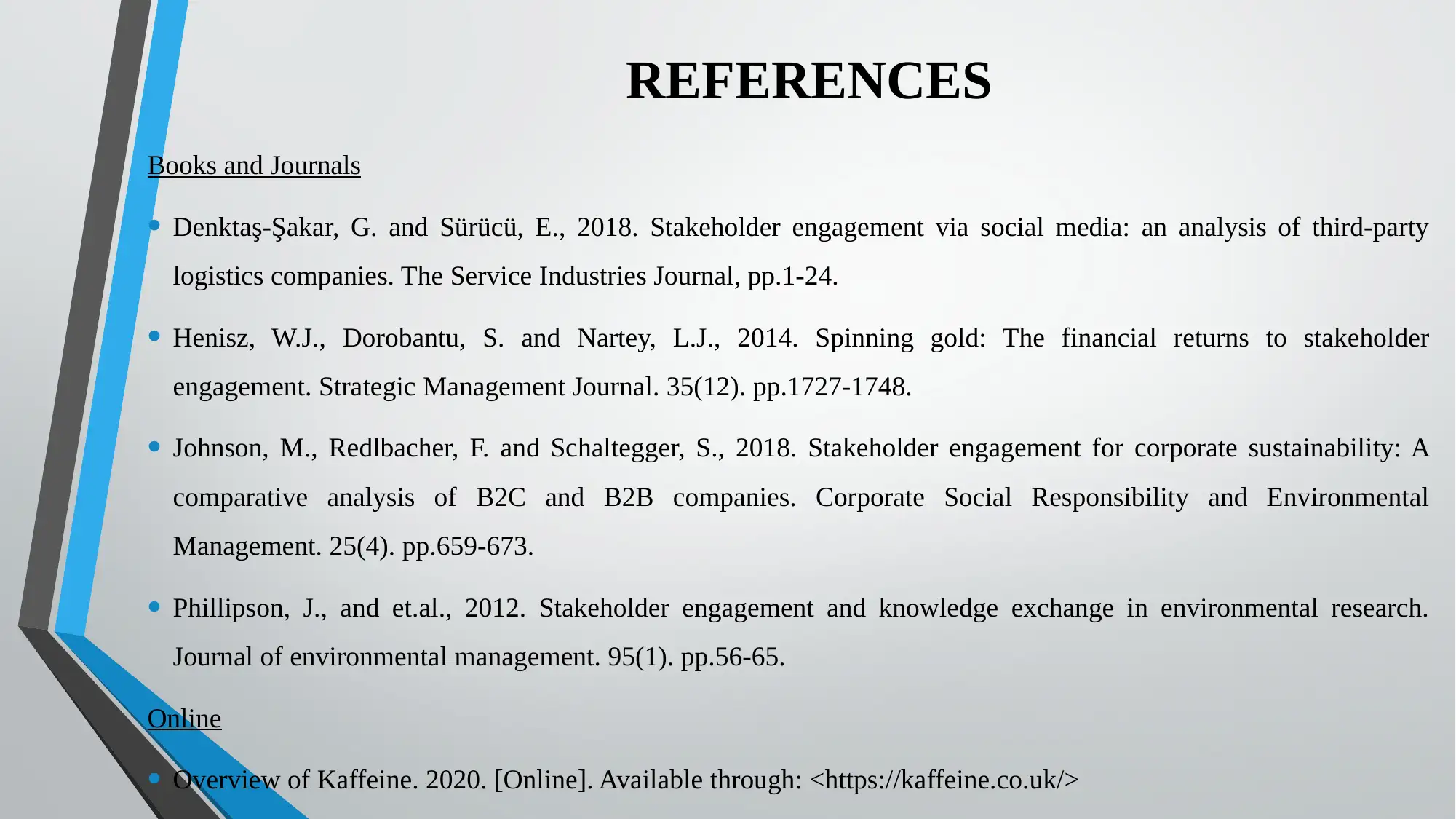
REFERENCES
Books and Journals
• Denktaş-Şakar, G. and Sürücü, E., 2018. Stakeholder engagement via social media: an analysis of third-party
logistics companies. The Service Industries Journal, pp.1-24.
• Henisz, W.J., Dorobantu, S. and Nartey, L.J., 2014. Spinning gold: The financial returns to stakeholder
engagement. Strategic Management Journal. 35(12). pp.1727-1748.
• Johnson, M., Redlbacher, F. and Schaltegger, S., 2018. Stakeholder engagement for corporate sustainability: A
comparative analysis of B2C and B2B companies. Corporate Social Responsibility and Environmental
Management. 25(4). pp.659-673.
• Phillipson, J., and et.al., 2012. Stakeholder engagement and knowledge exchange in environmental research.
Journal of environmental management. 95(1). pp.56-65.
Online
• Overview of Kaffeine. 2020. [Online]. Available through: <https://kaffeine.co.uk/>
Books and Journals
• Denktaş-Şakar, G. and Sürücü, E., 2018. Stakeholder engagement via social media: an analysis of third-party
logistics companies. The Service Industries Journal, pp.1-24.
• Henisz, W.J., Dorobantu, S. and Nartey, L.J., 2014. Spinning gold: The financial returns to stakeholder
engagement. Strategic Management Journal. 35(12). pp.1727-1748.
• Johnson, M., Redlbacher, F. and Schaltegger, S., 2018. Stakeholder engagement for corporate sustainability: A
comparative analysis of B2C and B2B companies. Corporate Social Responsibility and Environmental
Management. 25(4). pp.659-673.
• Phillipson, J., and et.al., 2012. Stakeholder engagement and knowledge exchange in environmental research.
Journal of environmental management. 95(1). pp.56-65.
Online
• Overview of Kaffeine. 2020. [Online]. Available through: <https://kaffeine.co.uk/>

THANKYOU
⊘ This is a preview!⊘
Do you want full access?
Subscribe today to unlock all pages.

Trusted by 1+ million students worldwide
1 out of 12
Related Documents
Your All-in-One AI-Powered Toolkit for Academic Success.
+13062052269
info@desklib.com
Available 24*7 on WhatsApp / Email
![[object Object]](/_next/static/media/star-bottom.7253800d.svg)
Unlock your academic potential
Copyright © 2020–2025 A2Z Services. All Rights Reserved. Developed and managed by ZUCOL.





